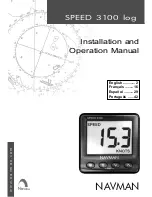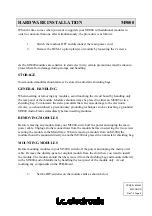
1942322
V1.5
27 June 2022
Installation:
This CLIFE-RECSP Recessed Non-maintained Emergency can be installed on PLASTER or T-BAR
ceilings or used to replace an existing unit.
•
First plan the assembly layout ensuring the battery is kept away from any heat source.
•
Refer Images and Dimensions below for the Cut-out Hole and other dimensions.
•
For products requiring a Corridor or Area Lens, replace Lens now (see below)
•
Use the two Spring Legs to mount the Head into the ceiling.
IMPORTANT:
Ensure Heads are
firmly fitted flush with the mounting surface to ensure water resistance. (See IP Ratings)
•
Please ensure the control pack and battery is suspended above the ceiling. If the control pack and
battery are to be mounted or placed on top of the ceiling, then please ensure the ceiling can
support these elements and in compliance with the relevant regulations with respect to mounting
above/on the ceiling.
•
If the CTP capabilities are activated, please affix the CTP status label to a visible surface and mark
an ‘’F’’ in third segment of the Four Segment Marking
Images and Dimensions:
Ceiling Cut-out:
80mm diam.
Battery pack:
160mm (L) x 47mm (W) x 25mm (H)
Lens Replacement
STEP 1 - Use a screwdriver to remove the Bezel, Gasket & Lens (Bezel clips highlighted below).
STEP 2 - Replace Lens (for corridor Lens align the locating pins as indicated below)
STEP 3 - Replace Bezel & Gasket (ensure Bezel is pressed firmly to ensure a proper seal)
IP Ratings:
Testing:
When the Lifelight unit is connected to the un-switched active, it must be allowed to charge the battery
for at least 24 hours. The emergency lamp only illuminates during a power fail. Conduct the following
tests:
•
The emergency lamp must illuminate for at least 2 hours after disconnection from the mains. The
results of all tests are required to be recorded in a service logbook, which is to be kept on-site at all
times. If the unit fails to illuminate for the requisite time, remedial action must be taken to repair the
situation and once completed, the unit must pass a subsequent test.
•
Press and hold Test Button or switch Off Mains Supply, check that the emergency lamp is On.
•
Release the Test Button or Switch On Mains Supply, check that the emergency lamp is Off (Non-
maintained operation).
Below are a list of common problems and their possible causes:
Fault:
The Green LED indicator is not illuminated.
Check: A.C. is connected and is turned on.
Battery is connected.
Test Switch for damage.
Fault:
Lamp does not illuminate in emergency mode.
Check: A.C. is connected.
Lamp is correctly inserted.
Battery is connected
Fault:
Lamp illuminates in emergency mode, but only stays on for a short period.
Check:
Battery has been allowed to charge for at least 24 hours.
Battery for damage.
Rated Emergency Lumen Output in accordance with AS2293.1 (refer
to spacing tables for installation positions):
Refer to the Technical Label for classification information.
Caution:
On many building sites, power circuits may be cut off in an uncontrolled and repetitive basis during
construction. As a result, any Lifelight Units, on these circuits, will have their batteries discharged or
“cycled”. The Li-ion battery in the Lifelight has been selected to give excellent long life performance in a
controlled IEC 60598-2-22 testing environment. Excessive battery cycling will reduce through-life
performance and may lead to premature battery failure. Battery warranty claims, as a result of such
abuse, are specifically EXCLUDED from Clevertronics warranty terms.
Warranty:
For Product Warranty information and Terms and Conditions of Sales please refer to our website
http://clevertronics.com.au/terms-conditions-sale-australia-nz/




















